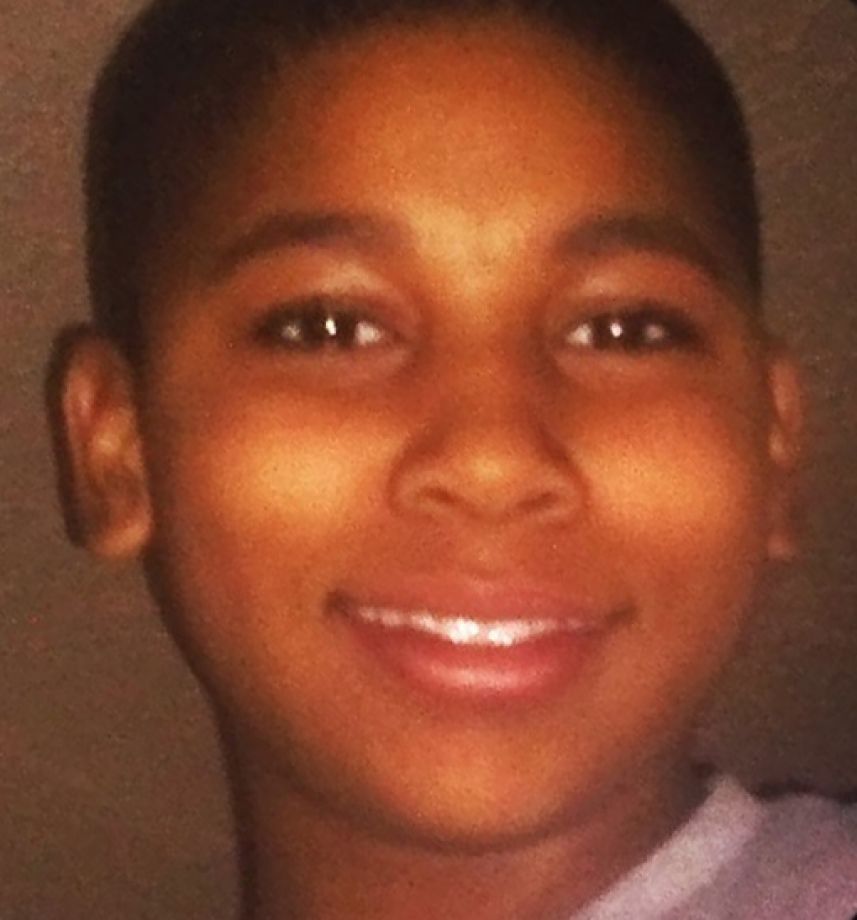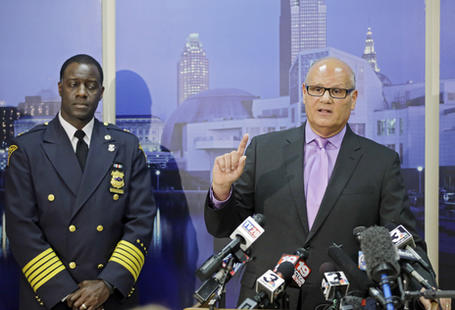|
CLEVELAND (AP) — A grand jury declined to indict a white rookie police officer in the killing of 12-year-old Tamir Rice, a black youngster who was shot while playing with what turned out to be a pellet gun, a prosecutor said Monday. Cuyahoga County prosecutor Tim McGinty said it was “indisputable” that the boy was gunned down while drawing the pistol from his waistband – either to hand the weapon over to police or to show them it wasn’t real. But McGinty said the officer and his partner had no way of knowing that. “Simply put, given this perfect storm of human error, mistakes and miscommunications by all involved that day, the evidence did not indicate criminal conduct by police,” McGinty said. He said patrolman Timothy Loehmann was justified in opening fire: “He had reason to fear for his life.” Tamir’s family condemned the decision but echoed the prosecutor in urging those disappointed to express themselves “peacefully and democratically.” Barricades were set up outside a Cleveland courthouse in case of protests, and a few demonstrators gathered, holding up pictures of Tamir and others killed by police around the country. A grainy surveillance-camera video of the boy’s November 2014 shooting provoked outrage nationally, and together with other killings of black people by police in places such as Ferguson, Missouri, and New York City, it helped fuel the Black Lives Matter movement. Tamir was gunned down by Loehmann within two seconds of the officer’s police cruiser skidding to a stop near the boy outside a city recreation center. Loehmann and his white training partner, Frank Garmback, were responding to a 911 call about a man waving a gun. Tamir was carrying a borrowed airsoft gun that looked like a real gun but shot nonlethal plastic pellets. It was missing its telltale orange tip. The grand jury had been hearing evidence and testimony since mid-October. In explaining the decision not to charge either officer, McGinty said police radio personnel contributed to the tragedy by failing to pass along the “all-important fact” that the 911 caller said the gunman was probably a youngster and the gun probably wasn’t real. Assistant Prosecutor Matthew Meyer said it was “extremely difficult” to tell the difference between the pellet gun and a real one. And he said Tamir was big for his age – 5-foot-7 and 175 pounds, with a men’s XL jacket and size-36 pants – and could have easily passed for someone much older. Before police arrived, the youngster was seen repeatedly drawing the gun from his waistband and pointing it at other children, Meyer said. “There have been lessons learned already. It should never happen again, and the city has taken steps so it doesn’t,” McGinty said. Among other things, the Cleveland police department is putting dashboard cameras in every car and equipping officers with bodycams. Also, the police department reached a settlement with the U.S. Justice Department earlier this year to overhaul its use of force. The settlement was prompted largely by a car chase that ended with the killing of a couple in a 137-shot barrage of police gunfire. In a statement, Tamir’s family said it was “saddened and disappointed by this outcome – but not surprised.” It accused the prosecutor of “abusing and manipulating the grand jury process to orchestrate a vote against indictment.” Tamir’s family charged that McGinty improperly hired use of-force experts to tell the grand jury that Loehmann’s actions were reasonable. The family also said that the prosecutor allowed the officers to read statements to the grand jury without being subjected to cross-examination. The family renewed its request for the U.S. Justice Department to step in and conduct “a real investigation.” Federal prosecutors in Cleveland noted Monday that a civil rights investigation into the case is already underway. In addition, Tamir’s family has filed a federal civil rights lawsuit against the two officers and the city. McGinty said it was a “tough conversation” with Tamir’s mother when she was told there would be no charges. “She was broken up, and it was very hard,” the prosecutor said. Both officers insisted that they shouted at Tamir repeatedly to show his hands before Loehmann opened fire from a distance estimated at 4½ to 7 feet. Loehmann fired twice, with one shot missing the boy. “With his hands pulling the gun out and his elbow coming up, I knew it was a gun and it was coming out. I saw the weapon in his hands coming out of his waistband and the threat to my partner and myself was real and active,” Loehmann told investigators. After the boy’s killing, it was learned that Loehmann had washed out from the police force in the Cleveland suburb of Independence. Loehmann had “dismal” handgun performance, broke down in tears at the gun range and was emotionally immature, according to files. He quit the force before he could be fired. Steve Loomis, the head of Cleveland’s police union, said the organization is pleased with the grand jury’s finding but said the decision “is no cause for celebration and there will be none.” McGinty urged those who disagree with the grand jury decision to react peacefully, and said: “It is time for the community and all of us to start to heal.” State Sen. Sandra Williams, a Cleveland Democrat, called the decision a “grave miscarriage of justice” but pleaded with the community to remain focused on positive change and “avoid falling into the traps that have hampered progress and the broader movement of social equality.” — Associated Press reporters Mitch Stacy, Kantele Franko and Julie Carr Smyth in Columbus and Dan Sewell in Cincinnati contributed to this story. © 2015 The Associated Press. All rights reserved. This material may not be published, broadcast, rewritten or redistributed. Learn more about our Privacy Policy and Terms of Use. |






